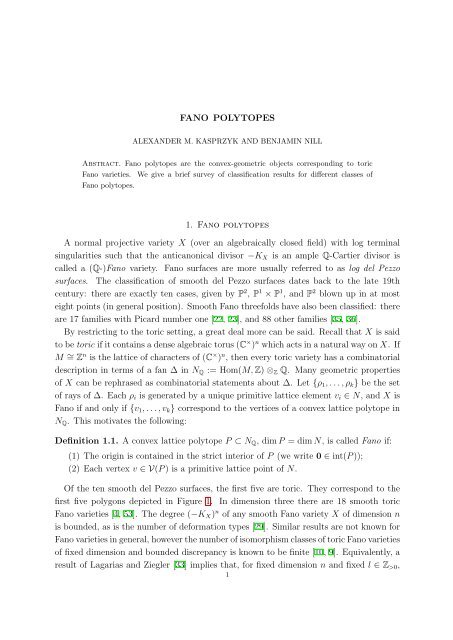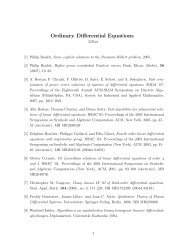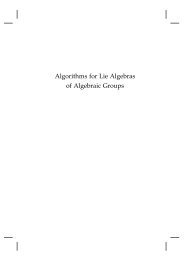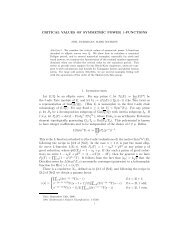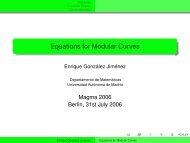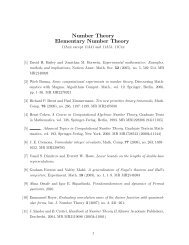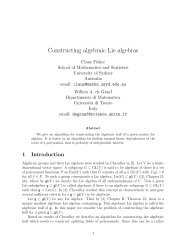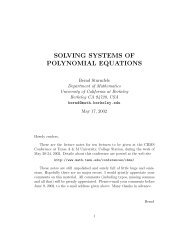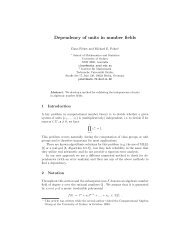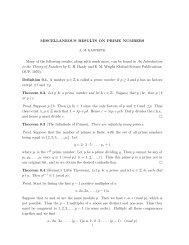FANO POLYTOPES 1. Fano polytopes A normal projective ... - Magma
FANO POLYTOPES 1. Fano polytopes A normal projective ... - Magma
FANO POLYTOPES 1. Fano polytopes A normal projective ... - Magma
Create successful ePaper yourself
Turn your PDF publications into a flip-book with our unique Google optimized e-Paper software.
<strong>FANO</strong> <strong>POLYTOPES</strong><br />
ALEXANDER M. KASPRZYK AND BENJAMIN NILL<br />
Abstract. <strong>Fano</strong> <strong>polytopes</strong> are the convex-geometric objects corresponding to toric<br />
<strong>Fano</strong> varieties. We give a brief survey of classification results for different classes of<br />
<strong>Fano</strong> <strong>polytopes</strong>.<br />
<strong>1.</strong> <strong>Fano</strong> <strong>polytopes</strong><br />
A <strong>normal</strong> <strong>projective</strong> variety X (over an algebraically closed field) with log terminal<br />
singularities such that the anticanonical divisor −KX is an ample Q-Cartier divisor is<br />
called a (Q-)<strong>Fano</strong> variety. <strong>Fano</strong> surfaces are more usually referred to as log del Pezzo<br />
surfaces. The classification of smooth del Pezzo surfaces dates back to the late 19th<br />
century: there are exactly ten cases, given by P 2 , P 1 × P 1 , and P 2 blown up in at most<br />
eight points (in general position). Smooth <strong>Fano</strong> threefolds have also been classified: there<br />
are 17 families with Picard number one [22, 23], and 88 other families [35, 36].<br />
By restricting to the toric setting, a great deal more can be said. Recall that X is said<br />
to be toric if it contains a dense algebraic torus (C × ) n which acts in a natural way on X. If<br />
M ∼ = Z n is the lattice of characters of (C × ) n , then every toric variety has a combinatorial<br />
description in terms of a fan ∆ in NQ := Hom(M, Z) ⊗Z Q. Many geometric properties<br />
of X can be rephrased as combinatorial statements about ∆. Let {ρ1, . . . , ρk} be the set<br />
of rays of ∆. Each ρi is generated by a unique primitive lattice element vi ∈ N, and X is<br />
<strong>Fano</strong> if and only if {v1, . . . , vk} correspond to the vertices of a convex lattice polytope in<br />
NQ. This motivates the following:<br />
Definition <strong>1.</strong><strong>1.</strong> A convex lattice polytope P ⊂ NQ, dim P = dim N, is called <strong>Fano</strong> if:<br />
(1) The origin is contained in the strict interior of P (we write 0 ∈ int(P ));<br />
(2) Each vertex v ∈ V(P ) is a primitive lattice point of N.<br />
Of the ten smooth del Pezzo surfaces, the first five are toric. They correspond to the<br />
first five polygons depicted in Figure <strong>1.</strong> In dimension three there are 18 smooth toric<br />
<strong>Fano</strong> varieties [4, 53]. The degree (−KX) n of any smooth <strong>Fano</strong> variety X of dimension n<br />
is bounded, as is the number of deformation types [29]. Similar results are not known for<br />
<strong>Fano</strong> varieties in general, however the number of isomorphism classes of toric <strong>Fano</strong> varieties<br />
of fixed dimension and bounded discrepancy is known to be finite [10, 9]. Equivalently, a<br />
result of Lagarias and Ziegler [33] implies that, for fixed dimension n and fixed l ∈ Z>0,<br />
1
2 A. M. KASPRZYK AND B. NILL<br />
Figure <strong>1.</strong> The 16 reflexive polygons, up to isomorphism.<br />
Table <strong>1.</strong> A summary of the known classifications of <strong>Fano</strong> <strong>polytopes</strong> [26].<br />
Terminal Canonical<br />
n Smooth Reflexive Simp. Total Reflexive Simplicial Total<br />
2 5 5 5 5 16 16 16<br />
3 18 [4, 53] 100 233 [24] 634 [24] 4,319 [31] 12,190 [26] 674,688 [26]<br />
4 124 [6, 52] 166,841[32] 473,800,776 [32]<br />
5 866 [30, 45]<br />
6 7,622 [45]<br />
7 72,256 [45]<br />
8 749,892 [45]<br />
there are only finitely many isomorphism classes of n-dimensional <strong>Fano</strong> <strong>polytopes</strong> with<br />
int(P ) ∩ lZ n = {0}.<br />
Classifications of <strong>Fano</strong> <strong>polytopes</strong> of fixed dimension n divide into finite classifications<br />
(usually by restricting the resulting singularities), and partial classifications of infinite<br />
families (these tend to allow log terminal singularities, but satisfy other combinatorial<br />
conditions). The currently known finite classifications are summarised in Table 1, along<br />
with references.<br />
2. Reflexive <strong>polytopes</strong><br />
In 1994 Batyrev [5] introduced reflexive <strong>polytopes</strong> as a key combinatorial tool for constructing<br />
topologically mirror-symmetric pairs of Calabi-Yau varieties as hypersurfaces<br />
in Gorenstein toric <strong>Fano</strong> varieties. This initiated an intense study of the geometric and<br />
combinatorial properties of reflexive <strong>polytopes</strong> [14, 19, 31, 32, 40, 42].<br />
Definition 2.<strong>1.</strong> A <strong>Fano</strong> polytope P ⊂ NQ is called reflexive if each facet of P has<br />
lattice distance one from 0. Equivalently, the dual polytope P ∗ := {u ∈ MQ | 〈u, v〉 ≥<br />
−1 for all v ∈ P } is a lattice polytope.<br />
Reflexive <strong>polytopes</strong> naturally appear as dual pairs: P is reflexive if and only if P ∗ is<br />
reflexive. As varieties they correspond to Gorenstein toric <strong>Fano</strong> varieties. Since they<br />
contain only one interior lattice point [5], there are finitely many reflexive <strong>polytopes</strong> up
<strong>FANO</strong> <strong>POLYTOPES</strong> 3<br />
to unimodular equivalence in each dimension n: 16 when n = 2, 4319 when n = 3,<br />
and 473, 800, 776 when n = 4 [31, 32]. This final value is, of course, the remarkable<br />
achievement of Max Kreuzer and Harald Skarke. Classification results for n ≥ 5 are<br />
probably only realistic for subclasses of reflexive <strong>polytopes</strong>.<br />
There are many open questions in higher dimensions. For example, it is still not known<br />
how many vertices a reflexive n-tope can have, although the maximal value is conjectured<br />
to be 6 n/2 when n is even, attained by the product of hexagons. Much more is known<br />
about simplicial reflexive <strong>polytopes</strong> (corresponding to Q-factorial Gorenstein toric <strong>Fano</strong><br />
varieties). Their combinatorics is quite restrictive: The vertex-edge-graph has diameter<br />
two, and given any vertex v ∈ V(P ) there exist at most three other vertices of P not<br />
contained in a facet containing v [40]. Casagrande [14] showed that the maximal number<br />
of vertices is 3n if n is even, or 3n − 1 if n is odd. Equivalently, this bounds the rank of<br />
the Picard group of the corresponding variety X, since rk Pic X = |V(P )| − dim P . The<br />
simplicial reflexive <strong>polytopes</strong> achieving these bounds have been classified [42].<br />
As special as reflexive <strong>polytopes</strong> are, it is interesting to note that in some sense they<br />
are rather general [19]:<br />
Proposition 2.2. Any lattice polytope is isomorphic to the face of a reflexive polytope.<br />
3. Smooth <strong>polytopes</strong><br />
A cone σ of a fan ∆ is non-singular if and only if the generators {v1, . . . , vk} of the<br />
rays of σ form part of a Z-basis for the lattice N. We shall call a <strong>Fano</strong> polytope P ⊂ NQ<br />
smooth if for each facet F ∈ F(P ), the vertices V(F ) of F are a Z-basis for N. Clearly<br />
any such polytope is necessarily simplicial and reflexive (the supporting hyperplane for<br />
F must lie at lattice distance one from 0). Note that in geometric combinatorics, the<br />
term “smooth” is often used in the dual sense: lattice <strong>polytopes</strong> whose tangent cones are<br />
unimodular.<br />
In dimension two, the classification of smooth polygons is well known – there are exactly<br />
five cases. A complete classification in dimension three was obtained by Batyrev [4] and,<br />
independently, by Watanabe and Watanabe [53] (18 cases), and in dimension four, the<br />
classification was done by Batyrev [6] and Sato [52] (124 cases).<br />
Batyrev [6] showed that the projection of a smooth n-tope P along a vertex v ∈ V(P ) is<br />
a reflexive (n − 1)-tope. Given the classification of reflexive (n − 1)-topes, there exists an<br />
algorithm [30] “unprojecting” a reflexive polytope P ′ in all possible ways to generate the<br />
smooth n-topes. Using the classification of reflexive 4-topes [32], the smooth <strong>polytopes</strong> in<br />
dimension five were classified. There exists 866 isomorphism classes. In particular [30]:
4 A. M. KASPRZYK AND B. NILL<br />
Proposition 3.<strong>1.</strong> Let X be an n-dimensional smooth toric <strong>Fano</strong> variety, n ≤ 5. Then<br />
there exists precisely one X in each dimension with maximal anticanonical degree (−KX) n .<br />
n 2 3 4 5<br />
(−KX) n 9 64 800 14762<br />
X P 2 P 3 P P 3(O P 3 ⊕ O P 3(3)) P P 4(O P 4 ⊕ O P 4(4))<br />
We conclude this section by discussing the work of Øbro [45], which was used to classify<br />
all smooth <strong>polytopes</strong> up to dimension eight.<br />
Definition 3.2. Let P be a <strong>Fano</strong> polytope. A facet F ∈ F(P ) is said to be special if<br />
v ∈ pos(F ).<br />
<br />
v∈V(P )<br />
Clearly any <strong>Fano</strong> polytope P has at least one special facet F . Since P is smooth<br />
we may assume that V(F ) = {e1, . . . , en}, the standard basis for N. This is called<br />
a special embedding for P . Let v = (a1, . . . , an) ∈ V(P ) be a vertex of P , so that<br />
gcd{a1, . . . , an} = 1, and define a := a1 + . . . + an. Then −n ≤ a ≤ 1 and each ai<br />
satisfies [45]:<br />
⎫<br />
0 ⎪⎬<br />
−1<br />
⎪⎭<br />
a<br />
≤ ai<br />
⎧<br />
⎪⎨ 1, if a = 1,<br />
≤ n − 1,<br />
⎪⎩<br />
n + a,<br />
if a = 0,<br />
if a < 0.<br />
Already this is a finite problem. In fact it is possible to avoid repetitions by carefully<br />
defining an order on the smooth <strong>polytopes</strong>. Let A and B be finite subsets of N. We<br />
recursively define A B if and only if A = ∅, or B = ∅ and min A ≺ min B ∨ (min A =<br />
min B ∧ A \ {min A} B \ {min B}).<br />
Definition 3.3. Let P be a smooth polytope. The order of P is given by<br />
ord(P ) := min{V(Q) | Q is a special embedding of P }.<br />
If P1 and P2 are two smooth <strong>polytopes</strong>, we say that P1 ≤ P2 if and only if ord(P1) <br />
ord(P2). This defines a total order on the set of isomorphism classes of smooth n-topes.<br />
A classification algorithm using this order can avoid expensive isomorphism testing by<br />
insisting that V(P ) = ord(P ). In particular, the classification can be generated in such a<br />
way that if P1 ≤ P2 then P1 is discovered before P2. This is very efficient, and has been<br />
used to classify all smooth <strong>polytopes</strong> up to dimension eight. Applications include new<br />
examples of Einstein-Kähler manifolds [43], and the study of Riemannian <strong>polytopes</strong> [21].<br />
4. Gorenstein <strong>polytopes</strong><br />
Definition 4.<strong>1.</strong> A lattice polytope Q ⊂ MQ is called Gorenstein of index r if there exists<br />
an integer r ∈ Z>0 and lattice point m ∈ rQ ∩ M such that rQ − m is reflexive.
<strong>FANO</strong> <strong>POLYTOPES</strong> 5<br />
Minkowski summands of reflexive <strong>polytopes</strong> define complete intersections (CYCIs) in<br />
Gorenstein toric <strong>Fano</strong> varieties. Their stringy Hodge numbers can be computed from the<br />
combinatorial and geometric data of the associated Cayley polytope [7, 12], which is a<br />
Gorenstein polytope [8]. In order to obtain a duality for this construction, one needs to<br />
consider special Minkowski summands called nef-partitions [11]. Not all Gorenstein <strong>polytopes</strong><br />
arise as Cayley <strong>polytopes</strong>, however stringy Hodge numbers of Gorenstein <strong>polytopes</strong><br />
are always well-defined [44] and satisfy the mirror-symmetry property [12].<br />
Gorenstein <strong>polytopes</strong> can be characterised in terms of the lattice distance of the supporting<br />
hyperplanes in much the same way as reflexive <strong>polytopes</strong>. A lattice polytope Q<br />
is Gorenstein of index r if and only if there exists a rational point x ∈ int(Q) ∩ (1/r)M<br />
having lattice distance 1/r from any facet F ∈ F(Q). Another characterisation can be<br />
given in terms of reflexive Gorenstein cones.<br />
Given an (n + 1)-dimensional lattice M with dual lattice N, recall that a cone σ ⊂ M Q<br />
is Gorenstein if it is generated by finitely many lattice points contained in an affine<br />
hyperplane Huσ := {x ∈ M Q | 〈x, uσ〉 = 1}, for some primitive vector uσ ∈ N. In<br />
particular, uσ ∈ int(σ ∨ ) is uniquely determined, and int(σ ∨ ) ∩ N = uσ + σ ∨ ∩ N.<br />
The height one slice σ∩Huσ defines an n-dimensional lattice polytope called the support<br />
of σ. Conversely, given any n-dimensional lattice polytope P ⊂ MQ, one can associate a<br />
Gorenstein cone σ in M := M ⊕ Z simply by taking cone(P × {1}). A Gorenstein cone<br />
σ is called reflexive if σ ∨ is also a Gorenstein cone. The value r := 〈uσ ∨, uσ〉 is called the<br />
index of σ.<br />
Batyrev and Borisov showed that reflexive Gorenstein cones correspond to Gorenstein<br />
<strong>polytopes</strong> [8]. Whilst Gorenstein <strong>polytopes</strong> do not possess interior lattice points when<br />
r > 1, they still satisfy a beautiful duality. Here, the dual Gorenstein polytope Q ∗ is<br />
defined to be the support of the dual cone σ ∨ . When r ≥ 1 it is not generally true<br />
that the reflexive <strong>polytopes</strong> rQ and rQ ∗ are dual to each other: one must move to a<br />
sublattice [3]. Nevertheless, (rQ) ∗ and Q ∗ have the same set of boundary lattice points.<br />
Analogous behaviour occurs in the study of l-reflexive polygons (see Section 7).<br />
There are 5363 Gorenstein 4-topes of index two, but only 36 Gorenstein <strong>polytopes</strong> of<br />
index three. Whilst a classification of reflexive <strong>polytopes</strong> in dimension n ≥ 5 is impractical,<br />
it is a more tractable task for Gorenstein <strong>polytopes</strong> of relatively large index[2]. We<br />
refer to the article of Harald Skarke in this volume for how this can be achieved in several<br />
cases up to dimension seven.<br />
5. Terminal and canonical <strong>polytopes</strong><br />
We say that a fan ∆ is terminal if each cone σ ∈ ∆ satisfies the following:
6 A. M. KASPRZYK AND B. NILL<br />
(1) The generators {v1, . . . , vk} of the rays of σ are contained in an affine hyperplane<br />
Hu,l := {v ∈ NQ | 〈u, v〉 = l} for some primitive vector u ∈ M and integer l ∈ Z>0;<br />
(2) The only other lattice point in the cone σ on or below Hu,l is the origin, i.e. {v ∈<br />
σ ∩ N | 〈u, v〉 ≤ l} = {0, v1, . . . , vk}.<br />
A toric variety X has at worst terminal singularities if and only if the cones of ∆ are<br />
all terminal. Relaxing the definition slightly to allow lattice points on Hu,l, one obtains<br />
the definition of a canonical cone, and X has canonical singularities [50].<br />
Definition 5.<strong>1.</strong> A <strong>Fano</strong> polytope P is called terminal if P ∩ N = V(P ) ∪ {0}. If<br />
int(P ) ∩ N = {0} then P is said to be canonical.<br />
Terminal singularities play an important role in birational geometry [34, 50, 38]. In<br />
dimension two, a consequence of Castelnuovo’s Contractibility Criterion is that a <strong>normal</strong><br />
surface has only terminal singularities if and only if it is smooth. Mori [37] proved that,<br />
with two exceptions, isolated canonical cyclic quotient singularities in dimension three are<br />
all either Gorenstein or terminal, whilst Reid [51] addressed the issue of classifying 3-fold<br />
terminal singularities.<br />
The only empty polygons (i.e. polygons Q such that Q ∩ Z 2 = V(Q)) are the triangle<br />
and the square – these are the possible facets of a terminal 3-tope P . Furthermore, if P<br />
is also simplicial and reflexive, then P must be smooth. There are 634 three-dimensional<br />
terminal <strong>polytopes</strong> [24], of which 233 are simplicial and 100 are reflexive.<br />
Consider now a canonical 3-tope. Up to isomorphism, there are 674, 688 possibilities<br />
[26]. In this case, there is no known a priori description of the facets that can occur,<br />
although inspection gives 4248 distinct facets, ranging from triangles (of which there are<br />
97 choices), through to a unique facet with 9 vertices and 7 interior points.<br />
The approach to classification is essentially the same in both the terminal and canonical<br />
case; we will describe the canonical setting.<br />
Definition 5.2. Let P be a canonical n-tope. We say that P is minimal if, for all<br />
v ∈ V(P ), the polytope conv(P ∩ N \ {v}) obtained by subtracting v from P is not a<br />
canonical n-tope.<br />
Given a canonical polytope P and a lattice point v ∈ N, take the convex hull P ′ :=<br />
conv(P ∪ {v}); if P ′ fails to be canonical then discard it. If one starts with the minimal<br />
canonical <strong>polytopes</strong>, one will achieve a complete classification using this technique. Assume<br />
that P ′ is obtained by adding the vertex v to P . The ray passing through the origin<br />
and −v will intersect ∂P in a point x on some face F not containing v. Take the smallest<br />
subset S ⊂ V(F ) such that x ∈ conv(S); the simplex conv(S ∪ {v}) contains the origin<br />
strictly in its (relative) interior, hence is a canonical simplex of dimension |S| ≤ dim P .
<strong>FANO</strong> <strong>POLYTOPES</strong> 7<br />
Since there are only finitely many such simplices [10, 9], there are only finitely many<br />
choices for v.<br />
All that remains is to describe the minimal <strong>polytopes</strong>. Again, we state the result only<br />
in the canonical case.<br />
Proposition 5.3. Any minimal canonical n-tope P is either a simplex, or can be written<br />
as P = conv(S ∪ P ′ ) for some S a minimal canonical k-simplex and P ′ a minimal canonical<br />
(n − k + r)-tope, where 0 ≤ r < k < n. Moreover, dim(S ∩ P ′ ) ≤ r, and r equals the<br />
number of common vertices of S and P ′ .<br />
By definition of minimality, given any canonical polytope Q there exists a minimal<br />
polytope P such that P ⊂ Q, hence Vol(P ∗ ) ≥ Vol(Q ∗ ). In dimension three there are 26<br />
minimum canonical <strong>polytopes</strong>, giving:<br />
Theorem 5.4. Let X be a toric <strong>Fano</strong> threefold with at worst canonical singularities. Then<br />
(−KX) 3 ≤ 72, with equality if and only if X is isomorphic to P(1, 1, 1, 3) or P(1, 1, 4, 6).<br />
6. <strong>Fano</strong> simplices<br />
Definition 6.<strong>1.</strong> Let P := conv{v0, . . . , vn} ⊆ NQ be a <strong>Fano</strong> simplex, and let (λ0, . . . , λn)<br />
be a positive collection of weights λ0 ≤ . . . ≤ λn such that gcd{λ0, . . . , λn} = 1 and<br />
λ0v0 + . . . + λnvn = 0. The rank one Q-factorial variety X associated with the spanning<br />
fan of P is called a fake weighted <strong>projective</strong> space with weights (λ0, . . . , λn).<br />
Besides being compelling combinatorial objects, <strong>Fano</strong> simplices arise naturally in toric<br />
Mori theory [49, 51, 10, 13]. Let ΛV(P ) denote the sublattice generated by the vertices<br />
V(P ) of P , and define the multiplicity of P to be the index mult P := [N : ΛV(P )].<br />
Then[10, 13, 15, 25]:<br />
Theorem 6.2. Let X be a fake weighted <strong>projective</strong> space with weights (λ0, . . . , λn), and<br />
let P be the associated simplex in NQ. Let Q ⊆ NQ be the simplex corresponding to<br />
Y := P(λ0, . . . , λn).<br />
(1) X ∼ = Y if and only if mult P = <strong>1.</strong><br />
(2) X is the quotient of the weighted <strong>projective</strong> space Y by the action of the finite<br />
group N/ΛV(P ) acting free in codimension one. In particular π1 1(X) = N/ΛV(P ).<br />
(3) There exists a Hermite <strong>normal</strong> form H with determinant mult P such that P =<br />
QH (up to the action of GLn(Z)).<br />
(4) If P is canonical (resp. terminal) then Q is canonical (resp. terminal) and<br />
mult P ≤<br />
h n−1<br />
λ1λ2 . . . λn<br />
= λ0<br />
h (−KY ) n , where h :=<br />
(5) If P is reflexive then Q is reflexive and mult P | mult Q ∗ .<br />
n<br />
λi.<br />
i=0
8 A. M. KASPRZYK AND B. NILL<br />
If P is canonical, Pikhurko [46] gives an upper bound on the sum of the weights h ≤<br />
2 3n−2 15 (n−1)2n+1<br />
. In dimensions two and three this is far from sharp (the maximum values<br />
are 1 + 2 + 3 = 6 and 5 + 6 + 22 + 33 = 66, respectively). There also exists a bound [25]<br />
λi ≤ h/(n − i + 2), for 2 ≤ i ≤ n.<br />
Reflexive simplices have been studied in some detail [5, 15, 41]. The crucial observation<br />
is:<br />
Proposition 6.3. Let Y = P(λ0, . . . , λn). Then Y is Gorenstein if and only if λi | h for<br />
all i.<br />
Recall that a family of positive natural numbers (k0, k1, . . . , kn) is called a unit partition<br />
if 1/k0 + 1/k1 + . . . + 1/kn = <strong>1.</strong> Clearly Gorenstein weighted <strong>projective</strong> spaces and unit<br />
partitions are in bijection via ki = h/λi. Closely associated with unit partitions is the<br />
Sylvester sequence<br />
y0 := 2, yj := 1 + y0 · · · yj−<strong>1.</strong><br />
Then max{k0, k1, . . . , kn} ≤ yn, h ≤ tn := yn − 1, and λi ≥ h/((i + 1)tn−i).<br />
We conclude with the following (c.f. Theorem 5.4) [41]:<br />
Theorem 6.4. Suppose that X is a Gorenstein fake weighted <strong>projective</strong> space.<br />
(1) If n = 3 then (−KX) 3 ≤ 72, with equality if and only if X is isomorphic to<br />
P(1, 1, 1, 3) or P(1, 1, 4, 6);<br />
(2) If n ≥ 4 then (−KX) n ≤ 2t 2 n−1, with equality if and only if X is isomorphic to<br />
P(1, 1, 2tn−1/yn−2, . . . , 2tn−1/y0).<br />
The results of Theorem 6.4 are conjectured to hold more generally for any Gorenstein<br />
<strong>Fano</strong> variety with canonical singularities. In dimension three this is known as the <strong>Fano</strong>–<br />
Iskovskikh conjecture, and was proven by Prokhorov [48].<br />
7. <strong>Fano</strong> polygons<br />
Log del Pezzo surfaces have been extensively studied by Nukulin, Alexeev, and Nakayama [1,<br />
39]. In the toric setting they correspond to the <strong>Fano</strong> polygons, which we usually refer<br />
to as LDP-polygons. The LDP-triangles were first studied by Dais [16, 17], followed by<br />
study of the LDP-polygons and a classification algorithm [18, 27].<br />
Definition 7.<strong>1.</strong> Let F ∈ F(P ) be a facet of an LDP-polygon P . There exists a unique<br />
primitive lattice vector uF ∈ M \ {0} such that 〈uF , F 〉 = {lF }, where lF is a positive<br />
integer called the local index of F . The index of P is defined by l := lcm{lF | F ∈ F(P )}.<br />
The value lF is the lattice distance of F from 0. Notice that l is the smallest positive<br />
integer such that lP ∗ is a lattice polygon; equivalently, l is the smallest integer such that<br />
−lKX is a Cartier divisor, and is often referred to as the Gorenstein index.
<strong>FANO</strong> <strong>POLYTOPES</strong> 9<br />
Table 2. The classification of LDP-polygons [27] with index l ≤ 17. Here<br />
n(l) is the total number of LDP-polygons, m(l) is the number of LDPtriangles<br />
(i.e. rank one toric log del Pezzo surfaces), nT (l) is the number of<br />
LDP-polygons with T-singularities [20], and mT (l) is the number of LDPtriangles<br />
with T-singularities.<br />
l 1 2 3 4 5 6 7 8 9 10 11 12 13 14 15 16 17<br />
n(l) 16 30 99 91 250 379 429 307 690 916 939 1279 1142 1545 4312 1030 1892<br />
m(l) 5 7 18 13 33 26 45 27 51 51 67 53 69 74 133 48 89<br />
nT (l) 16 30 11 11 1 56 0 1 2 20 0 66 0 5 28 1 0<br />
mT (l) 5 7 5 2 1 8 0 0 0 4 0 4 0 1 4 0 0<br />
For fixed index l, it is possible to classify all LDP-polygons [27]. The algorithm relies<br />
on the notion of a special facet, and was sufficient to allow all LDP-polygons up to index<br />
17 to be classified (see Table 2).<br />
Definition 7.2. A <strong>Fano</strong> polytope P is called l-reflexive if, for some l ∈ Z>0, the local<br />
index lF equals l for every facet F ∈ F(P ).<br />
The 1-reflexive <strong>polytopes</strong> are precisely the reflexive <strong>polytopes</strong> introduced by Batyrev [5].<br />
In fact they generalise many important combinatorial properties [28]. For example, P is lreflexive<br />
if and only if lP ∗ is l-reflexive. It is also tempting to regard Gorenstein <strong>polytopes</strong><br />
as being “ 1<br />
r -reflexive”.<br />
In dimension two the l-reflexive polygons form a special subclass of the LDP-polygons<br />
of index l. It is unusual for an LDP-polygon to be l-reflexive; for example, there are no<br />
l-reflexive polygons of even index. They satisfy a very restrictive condition [28]:<br />
Proposition 7.3. Let P ⊆ NQ be an l-reflexive polygon (or more generally an l-reflexive<br />
loop), and let ΛP ⊂ N denote the sublattice generated by the boundary points ∂P ∩ N.<br />
Then ΛlP ∗ = lΛP ∗ . Moreover, ΛP ⊂ N and lΛP ∗ ⊂ M are both sublattices of index l.<br />
As a corollary, P restricted to the lattice ΛP is a reflexive polygon Q, and Q∗ is isomorphic<br />
to lP ∗ with respect to ΛlP ∗. From this observation there follows an efficient<br />
classification algorithm. We also see why there exist no l-reflexive polygons of even index.<br />
For assume otherwise. Without loss of generality let F := conv{(a, l), (b, l)} ∈ F(P ) be a<br />
facet of P . Since the vertices are primitive, both a and b must be odd, hence the midpoint<br />
between the two is a non-vertex lattice point on F . By symmetry this is true for every<br />
facet of P , and similarly for lP ∗ . This property must also hold for the reflexive polytope<br />
Q given by restricting to ΛP , and for Q∗ . However, a brief glance at Figure 1 shows that<br />
this is impossible.<br />
We summarise the key results in the following theorem (c.f. Theorem 6.2 (1)-(3)).
10 A. M. KASPRZYK AND B. NILL<br />
Table 3. The classification of l-reflexive polygons [28] with index l ≤ 80.<br />
Here n(l) is the total number of l-reflexive polygons.<br />
l 1 3 5 7 9 11 13 15 17 19 21 23 25 27 29 31 33 35 37 39<br />
n(l) 16 1 12 29 1 61 81 1 113 131 2 163 50 2 215 233 2 34 285 3<br />
l 41 43 45 47 49 51 53 55 57 59 61 63 65 67 69 71 73 75 77 79<br />
n(l) 317 335 2 367 182 3 419 72 4 469 489 3 93 539 4 571 591 3 185 641<br />
Theorem 7.4. Let P ⊆ NQ be an l-reflexive polygon, and let Q be the restriction of P to<br />
ΛP . Let X(P ) denote the toric variety generated by the spanning fan of P .<br />
(1) X(P ) is Gorenstein if and only if [N : ΛP ] = <strong>1.</strong><br />
(2) X(P ) is the quotient of the Gorenstein surface X(Q) by the action of the finite<br />
group N/ΛP .<br />
(3) There exists a Hermite <strong>normal</strong> form H with determinant [N : ΛP ] such that P =<br />
QH (up to the action of GL2(Z)).<br />
Finally, we conclude with an intriguing combinatorial result. Recall that for any reflexive<br />
polygon Q, the sum |∂Q ∩ N| + |∂Q ∗ ∩ M| is twelve [47]. This can be proved<br />
combinatorially, or in terms of the associated toric variety using Noether’s formula. Since<br />
any property of the boundary points of reflexive polygons lifts to l-reflexive polygons, we<br />
have:<br />
Corollary 7.5. Let P ⊂ NQ be an l-reflexive polygon (or more generally an l-reflexive<br />
loop). Then |∂P ∩ N| + |∂(lP ∗ ) ∩ M| = 12.<br />
8. About Max Kreuzer (by the second author)<br />
Max had a sincere interest in the lattice polytope community to which he made lasting<br />
contributions. He also had a wonderfully approachable and generous personality. I recall<br />
a little incident when I first met him in January 2003 at snowy Oberwolfach, whilst I was<br />
still a PhD student. Max invited me to a snowball fight, however I was reluctant to throw<br />
a ball at this famous professor from Vienna. But he insisted, declaring, “Ich bin nicht aus<br />
Zuckerwatte.”<br />
Acknowledgments. The first author is supported by EPSRC grant EP/I008128/<strong>1.</strong><br />
The second author is supported by the US National Science Foundation (DMS 1203162),<br />
and is grateful to the Erwin Schrödinger Institute and Universität Wien for financial<br />
support.<br />
References<br />
<strong>1.</strong> Valery Alexeev and Viacheslav V. Nikulin, Del Pezzo and K3 surfaces, MSJ Memoirs, vol. 15, Mathematical<br />
Society of Japan, Tokyo, 2006.
<strong>FANO</strong> <strong>POLYTOPES</strong> 11<br />
2. Victor Batyrev and Dorothee Juny, Classification of Gorenstein toric del Pezzo varieties in arbitrary<br />
dimension, Mosc. Math. J. 10 (2010), no. 2, 285–316, 478.<br />
3. Victor Batyrev and Benjamin Nill, Combinatorial aspects of mirror symmetry, Integer points in<br />
polyhedra—geometry, number theory, representation theory, algebra, optimization, statistics, Contemp.<br />
Math., vol. 452, Amer. Math. Soc., Providence, RI, 2008, pp. 35–66.<br />
4. Victor V. Batyrev, Toric <strong>Fano</strong> threefolds, Izv. Akad. Nauk SSSR Ser. Mat. 45 (1981), no. 4, 704–717,<br />
927.<br />
5. , Dual polyhedra and mirror symmetry for Calabi-Yau hypersurfaces in toric varieties, J.<br />
Algebraic Geom. 3 (1994), no. 3, 493–535.<br />
6. , On the classification of toric <strong>Fano</strong> 4-folds, J. Math. Sci. (New York) 94 (1999), no. 1,<br />
1021–1050, Algebraic geometry, 9.<br />
7. Victor V. Batyrev and Lev A. Borisov, Mirror duality and string-theoretic Hodge numbers, Invent.<br />
Math. 126 (1996), no. 1, 183–203.<br />
8. , Dual cones and mirror symmetry for generalized Calabi-Yau manifolds, Mirror symmetry,<br />
II, AMS/IP Stud. Adv. Math., vol. 1, Amer. Math. Soc., Providence, RI, 1997, pp. 71–86.<br />
9. A. A. Borisov, Convex lattice <strong>polytopes</strong> and cones with few lattice points inside, from a birational<br />
geometry viewpoint, (2000), arXiv:math.AG/0001109.<br />
10. A. A. Borisov and L. A. Borisov, Singular toric <strong>Fano</strong> three-folds, Mat. Sb. 183 (1992), no. 2, 134–141,<br />
text in Russian. English transl.: Russian Acad. Sci. Sb. Math., 75 (1993), 277–283.<br />
1<strong>1.</strong> Lev A. Borisov, Towards the mirror symmetry for calabi-yau complete intersections in gorenstein<br />
toric fano varieties, (1993), arXiv:931000<strong>1.</strong><br />
12. Lev A. Borisov and Anvar R. Mavlyutov, String cohomology of Calabi-Yau hypersurfaces via mirror<br />
symmetry, Adv. Math. 180 (2003), no. 1, 355–390.<br />
13. Weronika Buczyńska, Toryczne przestrzenie rzutowe, Magister thesis, text in Polish, available from<br />
http://www.mimuw.edu.pl/∼jarekw/ (English translation from arXiv:0805.1211v1), June 2002.<br />
14. Cinzia Casagrande, The number of vertices of a <strong>Fano</strong> polytope, Ann. Inst. Fourier (Grenoble) 56<br />
(2006), no. 1, 121–130.<br />
15. Heinke Conrads, Weighted <strong>projective</strong> spaces and reflexive simplices, Manuscripta Math. 107 (2002),<br />
no. 2, 215–227.<br />
16. Dimitrios I. Dais, Geometric combinatorics in the study of compact toric surfaces, Algebraic and<br />
geometric combinatorics, Contemp. Math., vol. 423, Amer. Math. Soc., Providence, RI, 2006, pp. 71–<br />
123.<br />
17. , Classification of toric log del Pezzo surfaces having Picard number 1 and index ≤ 3, Results<br />
Math. 54 (2009), no. 3-4, 219–252.<br />
18. Dimitrios I. Dais and Benjamin Nill, A boundedness result for toric log del Pezzo surfaces, Arch.<br />
Math. (Basel) 91 (2008), no. 6, 526–535.<br />
19. Christian Haase and Ilarion V. Melnikov, The reflexive dimension of a lattice polytope, Ann. Comb.<br />
10 (2006), no. 2, 211–217.<br />
20. Paul Hacking and Yuri Prokhorov, Smoothable del Pezzo surfaces with quotient singularities, Compos.<br />
Math. 146 (2010), no. 1, 169–192.<br />
2<strong>1.</strong> Gábor Hegedüs and Alexander Kasprzyk, Roots of Ehrhart polynomials of smooth <strong>Fano</strong> <strong>polytopes</strong>,<br />
Discrete and Computational Geometry 46 (2011), no. 3, 488–499.<br />
22. V. A. Iskovskih, <strong>Fano</strong> threefolds. I, Izv. Akad. Nauk SSSR Ser. Mat. 41 (1977), no. 3, 516–562, 717.<br />
23. , <strong>Fano</strong> threefolds. II, Izv. Akad. Nauk SSSR Ser. Mat. 42 (1978), no. 3, 506–549.
12 A. M. KASPRZYK AND B. NILL<br />
24. Alexander M. Kasprzyk, Toric <strong>Fano</strong> threefolds with terminal singularities, Tohoku Math. J. (2) 58<br />
(2006), no. 1, 101–12<strong>1.</strong><br />
25. , Bounds on fake weighted <strong>projective</strong> space, Kodai Math. J. 32 (2009), 197–208.<br />
26. , Canonical toric <strong>Fano</strong> threefolds, Canad. J. Math. 62 (2010), no. 6, 1293–1309.<br />
27. Alexander M. Kasprzyk, Maximilian Kreuzer, and Benjamin Nill, On the combinatorial classification<br />
of toric log del pezzo surfaces, LMS Journal of Computation and Mathematics 13 (2010), 33–46.<br />
28. Alexander M. Kasprzyk and Benjamin Nill, Reflexive <strong>polytopes</strong> of higher index and the number 12,<br />
Electron. J. Combin. 19 (2012), no. 3, P9.<br />
29. János Kollár, Yoichi Miyaoka, and Shigefumi Mori, Rational connectedness and boundedness of <strong>Fano</strong><br />
manifolds, J. Differential Geom. 36 (1992), no. 3, 765–779.<br />
30. Maximilian Kreuzer and Benjamin Nill, Classification of toric <strong>Fano</strong> 5-folds, Adv. Geom. 9 (2009),<br />
no. 1, 85–97.<br />
3<strong>1.</strong> Maximilian Kreuzer and Harald Skarke, Classification of reflexive polyhedra in three dimensions, Adv.<br />
Theor. Math. Phys. 2 (1998), no. 4, 853–87<strong>1.</strong><br />
32. , Complete classification of reflexive polyhedra in four dimensions, Adv. Theor. Math. Phys.<br />
4 (2000), no. 6, 1209–1230.<br />
33. Jeffrey C. Lagarias and Günter M. Ziegler, Bounds for lattice <strong>polytopes</strong> containing a fixed number of<br />
interior points in a sublattice, Canad. J. Math. 43 (1991), no. 5, 1022–1035.<br />
34. Shigefumi Mori, Threefolds whose Canonical Bundles are not Numerically Effective, Ann. of Math.<br />
(2) 116 (1982), no. 1, 133–176.<br />
35. Shigefumi Mori and Shigeru Mukai, Classification of <strong>Fano</strong> 3-folds with B2 ≥ 2, Manuscripta Math.<br />
36 (1981/82), no. 2, 147–162.<br />
36. , Erratum: “Classification of <strong>Fano</strong> 3-folds with B2 ≥ 2”, Manuscripta Math. 110 (2003),<br />
no. 3, 407.<br />
37. David R. Morrison, Canonical quotient singularities in dimension three, Proc. Amer. Math. Soc. 93<br />
(1985), no. 3, 393–396.<br />
38. David R. Morrison and Glenn Stevens, Terminal quotient singularities in dimensions three and four,<br />
Proc. Amer. Math. Soc. 90 (1984), no. 1, 15–20.<br />
39. Noboru Nakayama, Classification of log del Pezzo surfaces of index two, J. Math. Sci. Univ. Tokyo<br />
14 (2007), no. 3, 293–498.<br />
40. Benjamin Nill, Gorenstein toric <strong>Fano</strong> varieties, Manuscripta Math. 116 (2005), no. 2, 183–210.<br />
4<strong>1.</strong> , Volume and lattice points of reflexive simplices, Discrete Comput. Geom. 37 (2007), no. 2,<br />
301–320.<br />
42. Benjamin Nill and Mikkel Øbro, Q-factorial Gorenstein toric <strong>Fano</strong> varieties with large Picard number,<br />
Tohoku Math. J. (2) 62 (2010), no. 1, 1–15.<br />
43. Benjamin Nill and Andreas Paffenholz, Examples of Kähler-Einstein toric <strong>Fano</strong> manifolds associated<br />
to non-symmetric reflexive <strong>polytopes</strong>, Beitr. Algebra Geom. 52 (2011), no. 2, 297–304.<br />
44. Benjamin Nill and Jan Schepers, Gorenstein <strong>polytopes</strong> and their stringy E-functions, (2010),<br />
arXiv:1005.5158 [math.CO].<br />
45. Mikkel Øbro, An algorithm for the classification of smooth <strong>Fano</strong> <strong>polytopes</strong>, (2007),<br />
arXiv:0704.0049v1 [math.CO], classifications available from http://grdb.lboro.ac.uk/.<br />
46. Oleg Pikhurko, Lattice points in lattice <strong>polytopes</strong>, Mathematika 48 (2001), no. 1-2, 15–24 (2003).<br />
47. Bjorn Poonen and Fernando Rodriguez-Villegas, Lattice polygons and the number 12, Amer. Math.<br />
Monthly 107 (2000), no. 3, 238–250.
<strong>FANO</strong> <strong>POLYTOPES</strong> 13<br />
48. Yu. G. Prokhorov, The degree of <strong>Fano</strong> threefolds with canonical Gorenstein singularities, Mat. Sb.<br />
196 (2005), no. 1, 81–122.<br />
49. Miles Reid, Decomposition of toric morphisms, Arithmetic and geometry, Vol. II, Progr. Math.,<br />
vol. 36, Birkhäuser Boston, Boston, MA, 1983, pp. 395–418.<br />
50. , Minimal Models of Canonical 3-folds, Adv. Stud. Pure Math., Algebraic Varieties and Analytic<br />
Varieties 1 (1983), 131–180.<br />
5<strong>1.</strong> , Young person’s guide to canonical singularities, Algebraic geometry, Bowdoin, 1985<br />
(Brunswick, Maine, 1985), Proc. Sympos. Pure Math., vol. 46, Amer. Math. Soc., Providence, RI,<br />
1987, pp. 345–414.<br />
52. Hiroshi Sato, Toward the classification of higher-dimensional toric <strong>Fano</strong> varieties, Tohoku Math. J.<br />
(2) 52 (2000), no. 3, 383–413.<br />
53. K. Watanabe and M. Watanabe, The classification of <strong>Fano</strong> 3-folds with torus embeddings, Tokyo J.<br />
Math. 5 (1982), no. 1, 37–48.<br />
Department of Mathematics, Imperial College London, London, SW7 2AZ, UK<br />
E-mail address: a.m.kasprzyk@imperial.ac.uk<br />
Department of Mathematics, Case Western Reserve University, Cleveland, OH, USA<br />
E-mail address: benjamin.nill@case.edu


